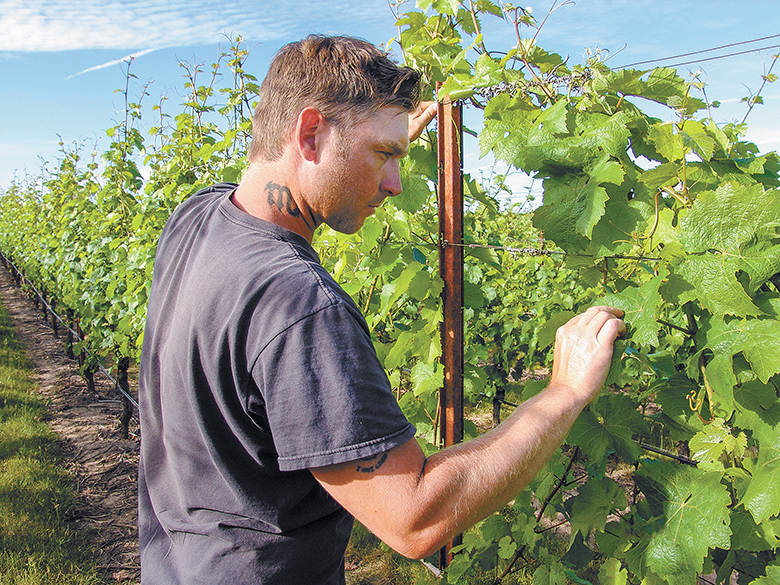You Spilled Pinot in My Spätburgunder
Comparing the Willamette Valley With the Pfalz of Germany
By Bill Hooper
My family arrived in Oregon just prior to the 2013 harvest. I had just spent the last three-plus years studying viticulture, viniculture and making wine in the Pfalz winegrowing region — the northern continuation of Alsace across the border into Germany.
After researching the climate and geology of all the major wine-producing areas in the U.S., we made the decision to pack up and relocate to the Willamette Valley. Based on the similarities of the two regions, I was convinced we would be able to produce wines using vineyard management and cellar techniques I learned in Germany.
It has been an incredible couple of years, and during this time, I‘ve had the chance to reflect upon the differences, but also what these two amazing winegrowing areas have in common.
Cool-climate winemaking is not for the weak of heart. Pruning in the cold, wet winter means raw hands, busted knuckles and boots filled with four inches of water. In the spring, you are always trying to impossibly forecast the remaining seven or eight months of the growing season while making estimations and concessions regarding late-season frosts, shoot thinning and bud counts, encompassing both the best and worst-case scenarios. Summer hours are spent trouncing up steep hills in the sometimes scorching heat, all the while diligently positioning shoots and pulling leaves in preparation for autumn rain, fog and the possibility of botrytis. September, October and even November are a blur. These are the days and weeks of picking and sorting and looking to the western sky and hoping and praying that the rain will wait or stop.

Behind all the work, anticipation and sleepless nights lies the force driving the wine industry. Passion goes without saying, but a better word is optimism. Winemaking in a marginal climate is romantic and necessarily uncomfortable. We not only accept, but embrace vintage variability. Every few years, we find ourselves in the position to defend a challenging vintage to those more accustomed to predictability and uniformity in style, but our conviction that great wines can be produced only on the edge of adversity is reinforced every passing year. If you ask a winemaker which vintage they are most proud of, it usually comes down to one of the most difficult.
Throughout their respective winemaking histories, both Germany and Oregon have been told what they can’t do, and both places have placed the chip a little higher on their shoulders and proved the detractors wrong.
The vibrancy of the wines produced is not only a function of the climate, but also of the soil. In the Willamette Valley as well as in the Pfalz, we are blessed with a myriad of soil types that contribute to the character of our wines. The most expensive vineyard land in Germany —200 euros per square meter — is found in the village of Forst in the Pfalz. It is so prized because it is composed mainly of basalt, a weathered volcanic rock very high in nutrients and able to retain water. The grape skins tend to be thicker, which is a catalyst for flavor while also protecting against the onset of botrytis. The basalt is basically a super-food for grapevines and produces the most exotically aromatic and most expensive Riesling in the country. The good news for us in the Willamette is that you can hardly throw a stone without that stone being volcanic, not to mention said stone landing in volcanic soil.
Another distinct advantage for Oregon is the lack of summer rain, and with that, reduced pressure for mildew. After botrytis, the number one enemy of German vines is downy mildew (Peronospora), practically unheard of in Oregon. The biggest issue of late in the EU concerning Organic viticulture is the use of copper to combat downy mildew and the residual build-up of that element in the soil — they are discovering copper is detrimental to the microbial life that essentially supports the vines. We live in a climate here in the Willamette Valley where Organic and Biodynamic viticulture are much easier to implement.
There are also differences in vineyard labor and mechanization, two issues that must be addressed by Oregonians in the near future. Machine harvesting is used in Germany for the production of very cheap wines — 3 to 7 euros per bottle. It is certainly less suitable for higher-end Pinot Noir but is likely the method that will gain a foothold here in the face of inevitable labor shortages.
Oregon is, of course, synonymous with great Pinot Noir; and Germany, great Riesling. But what has struck me is the emergence of other grape varieties in both places that, while not playing lead banjo, nevertheless add richness and depth to the ensemble.
I came here not to produce Pinot Noir, but Riesling. I’ve found great wines from the likes of Brooks, Big Table Farm, Chehalem, Love & Squalor, Teutonic, Trisaetum, Ovum and Mad Violets helped to reinforce my decision. In Germany, Pinot Noir (Spätburgunder) has become statistically tied for second-place after Riesling for the most-planted grape variety in the country, and Germany ranks third — after France and the U.S. — in Pinot Noir production worldwide.
In Germany, Pinot Blanc is held in higher regard than Pinot Gris, and many of the best wines in the world from that variety now come from the Pfalz, Baden and Nahe. Sauvignon Blanc, once forbidden by Hitler from being planted because of its “un-Germaness” has become very trendy. The excellent Sauvignon from J. Christopher and Patricia Green are proof that it has a home in Oregon as well. The biggest surprise for me in both locales was the small, but amazing, selection of Syrah being produced. Knipser and Kuhn from the Pfalz, and Matello and Cristom here in Oregon are making delicious, important Syrah from places no one could have predicted. Chardonnay will almost certainly play a more substantial role in our future wine landscape. Producers such as Eyrie, Cameron, Bethel Heights, Brick House, Brittan, St. Innocent and DDO have been making outstanding Oregon Chard for years, and a new generation has also embraced that grape.
This diversity is not something to take for granted. There aren’t many viticultural areas in the world that can produce such a broad swath of grape varieties so successfully.
I remember the long hours and months of pruning on hillside vineyards in Germany that were covered in snow. My Polish coworkers would share with me hot tea (or something stronger if weather required it) and tell stories of their home. I remember thinking about the significance of doing this job that had been done in this ancient place every year for centuries. It was very humbling. I sometimes get a similar feeling working in the vineyards of the Willamette Valley, but for different reasons.
The industry here was started from scratch by people who had a vision to produce something special straight out of the gate. They had to catch up quickly and make do with what they had. Resourcefulness and the will to succeed are what the wine industry here is founded on. In Europe, the tendency is to look back to the past. In Oregon, we should all be very excited about the future.
Bill Hooper graduated from the DLR-Neustadt and has made wine in Germany and Oregon. He owns Paetra Wine Company and enjoys baseball and pork products.
TOP: Oregon winemaker Bill Hooper learned winemaking in Germany in places like Oppenheimer Sackträger vineyard in the Rheinhessen region. ABOVE: Hooper checks on Riesling at Methven Vineyards located in the WIllamette Valley. He is championing the varietal with his brand, Paetra Wine Company.


 Bill Hooper graduated from the DLRNeustadt and has made wine in Germany and Oregon. He owns Paetra Wine Company and enjoys baseball and pork products.
Bill Hooper graduated from the DLRNeustadt and has made wine in Germany and Oregon. He owns Paetra Wine Company and enjoys baseball and pork products.






